The HTC One (M8) Review
by Anand Lal Shimpi & Joshua Ho on March 26, 2014 7:00 PM EST- Posted in
- Smartphones
- HTC
- Mobile
- HTC One
Snapdragon 801 Performance
The M8 is the first smartphone we’ve tested to use Qualcomm’s newly announced Snapdragon 801 SoC. At a high level the 801 is a frequency bump enabled by a 28nm HPm process push, giving it a tangible increase in performance (and potential decrease in power consumption) compared to the outgoing Snapdragon 800. The table below compares the 801 variants to the Snapdragon 800:
| Snapdragon 800/801 Breakdown | ||||||||||
| SoC Version | Model | Max CPU Frequency | Max GPU Frequency | ISP | eMMC | DSDA | Memory IF | |||
| MSM8974VV | v2 | S800 | 2.2GHz | 450MHz | 320MHz | 4.5 | N | 800MHz | ||
| MSM8974AA | v2 | S800 | 2.3GHz | 450MHz | 320MHz | 4.5 | N | 800MHz | ||
| MSM8974AB | v2 | S800 | 2.3GHz | 550MHz | 320MHz | 4.5 | N | 933MHz | ||
| MSM8974AA | v3 | S801 | 2.3GHz | 450MHz | 320MHz | 5.0 | Y | 800MHz | ||
| MSM8974AB | v3 | S801 | 2.3GHz | 578MHz | 465MHz | 5.0 | Y | 933MHz | ||
| MSM8974AC | v3 | S801 | 2.5GHz | 578MHz | 465MHz | 5.0 | Y | 933MHz | ||
In most parts of the world the M8 will ship with a 2.3GHz Snapdragon 801. In Asia/China however we’ll see the 2.5GHz MSM8974AC v3 SKU instead.
Compared to the outgoing Snapdragon 800, peak CPU performance shouldn’t increase all that much. What we may see however is an improvement in power efficiency thanks to the improved 28nm HPm process.
It’s really the GPU that will see the largest increase in performance. With a maximum speed of 578MHz and paired with faster LPDDR3-1866 memory, we should see up to a 30% increase in GPU bound performance over Snapdragon 800 designs.
- Physics
| Snapdragon 801 vs 800 vs 600 | |||||||
| HTC One (M8) - Snapdragon 801 | Google Nexus 5 - Snapdragon 800 | HTC One (M7) - Snapdragon 600 | 801 vs 800 | 801 vs 600 | |||
| SunSpider 1.0.2 | 772.8 ms | 686.9 ms | 1234.8 ms | -12% | +37% | ||
| Kraken Benchmark 1.1 | 6745.2 ms | 7245.9 ms | 12166.5 ms | +7.4% | +45% | ||
| Google Octane v2 | 4316 | 3726 | 3103 | +16% | +39% | ||
| WebXPRT Overall | 373 | 392 | 244 | -5% | +53% | ||
| AndEBench - Native | 17430 | 17480 | 12381 | -1% | +41% | ||
| 3DMark 1.1 Ultimate | 19631 | 17529 | 10519 | +12% | +87% | ||
| 3DMark 1.1 Ultimate - Physics | 50.5 | 51 | 33.1 | -1% | +53% | ||
| Basemark X 1.1 - HQ | 12194 | 11275 | 4807 | +8.1% | +154% | ||
| GFXBench 3.0 - Manhattan Onscreen | 11.1 fps | 9.3 fps | 5.1 fps | +19% | +118% | ||
| GFXBench 3.0 - Manhattan Offscreen | 10.4 fps | 8.7 fps | 4.4 fps | +20% | +136% | ||
| GFXBench 3.0 - T-Rex HD Onscreen | 29.9 fps | 24.3 fps | 12.6 fps | +23% | +137% | ||
| GFXBench 3.0 - T-Rex HD Offscreen | 27.9 fps | 22.9 fps | 12.6 fps | +22% | +121% | ||
CPU Performance
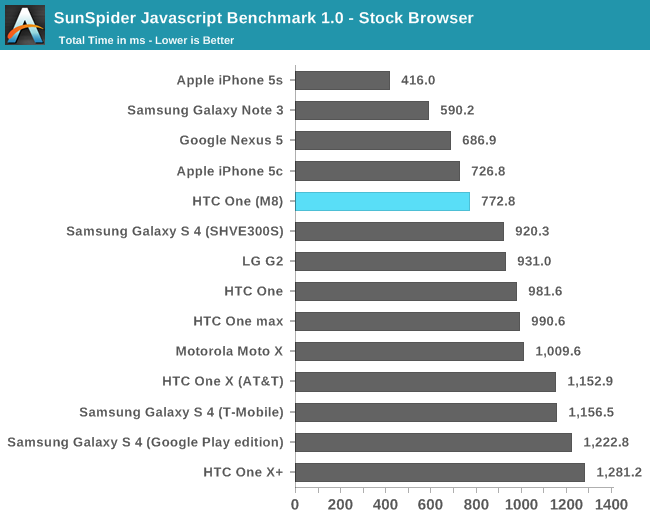
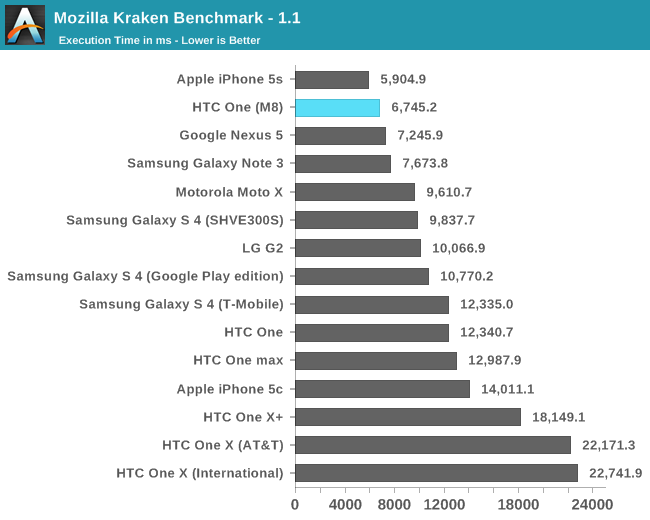
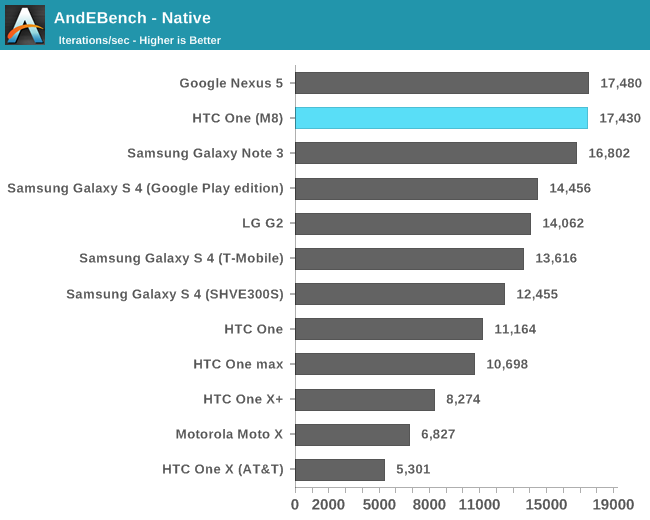
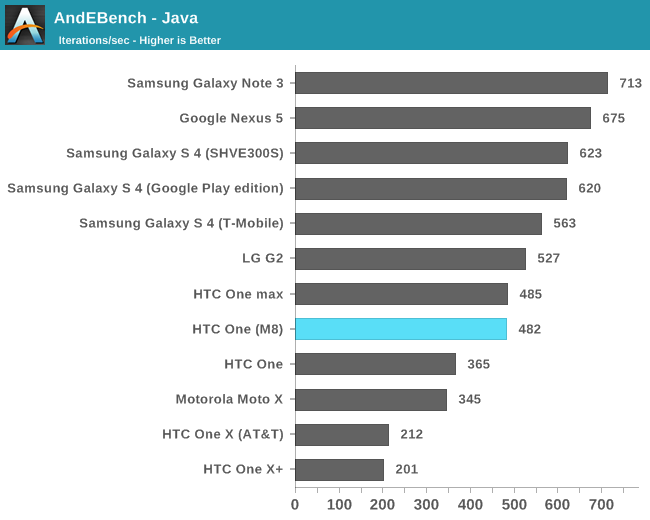
GPU Performance
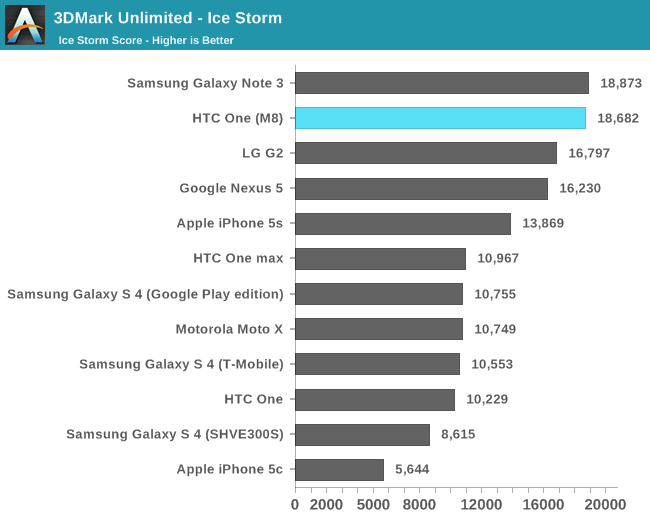
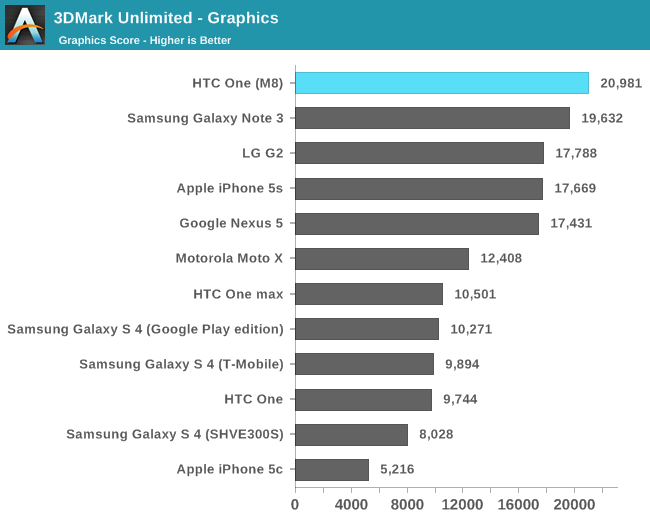
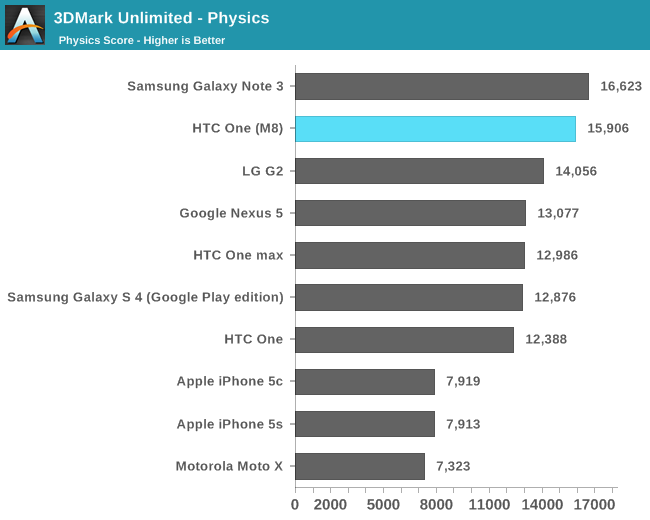
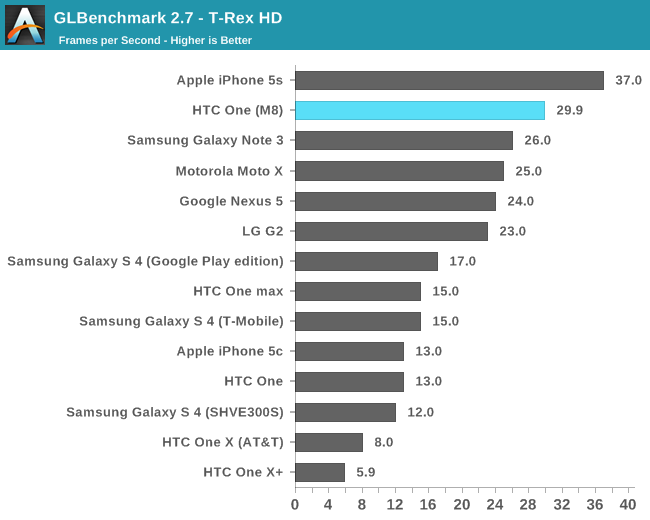
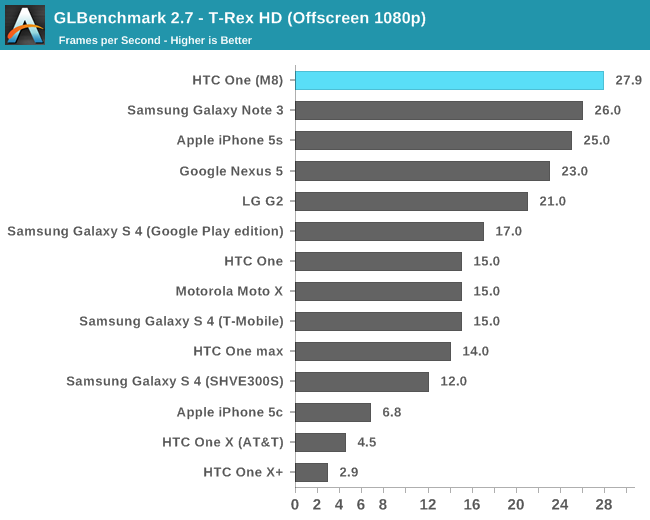
NAND Performance
The One is available in either 16GB or 32GB configurations, there are no higher capacity versions offered. There is now a micro SD card slot on the right side of the device, just above the volume rocker.
Despite using a Snapdragon 801 SoC, the internal storage is still an eMMC 4.5 solution.
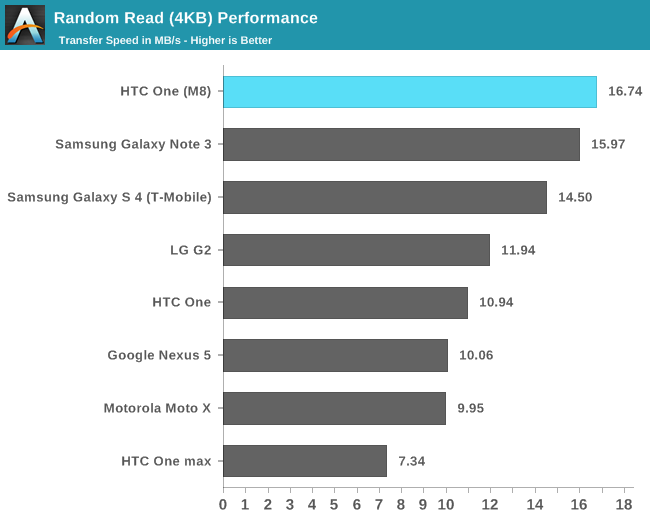
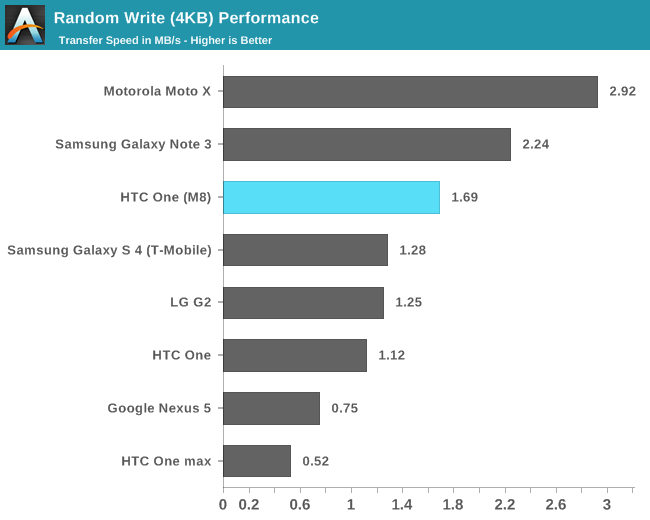

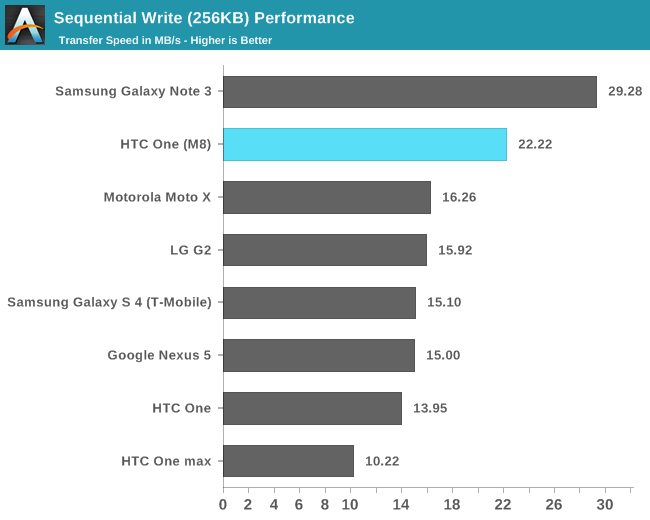


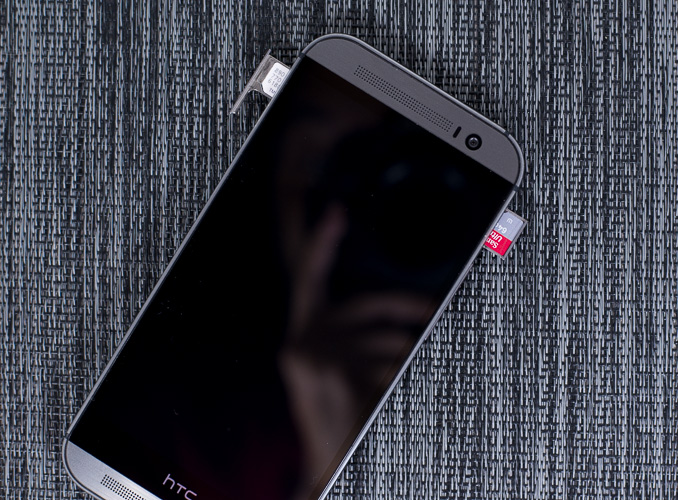








222 Comments
View All Comments
doosh bag - Thursday, March 27, 2014 - link
In order for HTC to build this phone with the "6-8 megapixel" people keep screaming they can't live without, they would've had to raise the price considerably to make the phone profitable. Don't forget HTC's revenues were down almost 50% in Q4 2013 from Q4 2012. It's quite easy for people to sit around in the comment box of someone else's blog and wax intellectual about how to spend HTC's money. If this phone sells like the M7, we may not see a M9.Death666Angel - Friday, March 28, 2014 - link
Lose the second camera, lose the expensive all metal unibody, which obviously people don't need (look at other top selling smartphones) and give me the 6-8MP Ultrapixel sensor for the same price. There, I solved your problem. Now HTC has just done "more of the same" while giving us "less of some stuff". Of a phone that probably wasn't a big hit, or else they would be doing better. I don't understand their strategy at all.evonitzer - Saturday, March 29, 2014 - link
Heck, lose the 801 (who needs that performance anyway), lose the Wifi AC (impossible to find in the wild), cut the screen resolution (nobody needs more than qHD say I) ... what else can I cut and still have a phone? LTE! Get rid of it.Seriously, what's the point of innovating or trying. Just be boring and people will buy it.
jospoortvliet - Sunday, March 30, 2014 - link
I sure as he'll wouldn't have bought it if it was another plasticy piece of crap like the Samsung's... Their strategy is fine, they just need more/better priced midrange phones.hero4hire - Sunday, March 30, 2014 - link
Exactly. It's not like the consumer is footing the bill for the all metal vs plastic. If there was a tradeoff for metal & 4mp or vs plastic 16mp "ultra" it would be worth a discussion. Maybe they could make that phone too. I d bet we find s5 and one (2014) for the same USA subsidy price as is.CoryWeston101 - Monday, March 31, 2014 - link
Cut the metal unibody? You are a daft one.LAWSON72 - Wednesday, March 26, 2014 - link
S5 for water proof and less to worry about since it is plastic, or this for the beautiful metal design, and touchscreen nav buttons. A tough decision, I just know I am getting bored with my S4 and the Nexus 5 sadly is not ever going to be on Verizon, so it is a choice between these two.antef - Wednesday, March 26, 2014 - link
Curious why you're "happy to see a move to nano sim as well." What difference or advantage does it make for the consumer? They can be harder to find on pre-paid carriers. Seems like it only exists due to Apple's relentless desire to always be using something different from everyone else.Braumin - Wednesday, March 26, 2014 - link
Simple. Nano sim in this case made room for dual sim on some models, and likely freed up space for micro SD, although making the body taller likely helped too.Plus the nano sim was made a standard so why not? You can make the argument it's the wrong standard, but it won out.
antef - Thursday, March 27, 2014 - link
I don't think "micro SIM being too big" was ever a reason for excluding things like micro SD slots, that decision is mostly made for other reasons and HTC probably just included it this time to try to differentiate some. I'm okay with a new standard if it's universally available, but until recently and maybe even now that hasn't been the case (again regarding pre-paid carriers).